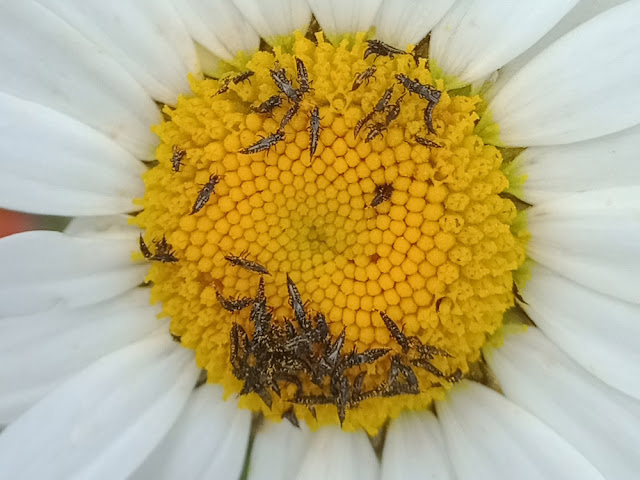Thrips belong to the taxonomic order Thysanoptera (so they are not bugs or beetles or flies, but an order all of their own).
Thrips on a daisy, photographed at nearly 2000 metres above sea level, near Lac du Gaube in the Pyrenees.
There are more than 6000 species, some of which are known as 'thunderbugs' and others which are considered garden or crop pests, being vectors for a number of plant viruses. But many are pollinators. Thrips are the sort of organisms that frequently get transferred from one Continent to another due to global trade, so many places have both native and introduced species. The ones that live on Australian Acacias are particularly well studied. Many species are social, living in colonies and prepared to defend their territory.
New species are regularly discovered. A few are predatory, eating mites and tiny insects; some are parasites; some cause galls on their host plants and about half feed on plants, eating leaves and buds, creating galleries or silver trails; the others feed on fungi. In turn, thrips are predated by other insects such as Robber Flies Asilidae and some flower bugs. Thrips are very small, sometimes under 2mm in length, and have sucking piercing mouthparts. Many are attracted to bright floral coloured clothing and have been known to 'bite' humans (they are attempting to feed and are harmless).
They've been around for a long time, with thrips found attached to pollen in amber from the Cretaceous period. Apparently they often cause havoc in plant breeding nurseries, by transporting pollen from one plant to another in a way the horticulturalists don't want to happen. Charles Darwin had trouble with them when he was studying pollenisation and noted that 'no netting will keep them out'. They are prone to aggregating inside houses and can insert themselves between a laptop computer or television LCD screen and its glass cover (I've had that happen, with a thrips walking around all over my screen for days). Thrips are resistant to insecticides and there is no real way of controlling them if numbers get out of hand.


3 comments:
At certain times of year I have discovered that wearing a bright yellow top is not a good move! I didn't realise that the tickling sensation is actual biting. They may be harmless but it's not pleasant.
Lovely little beasts!
They also do very well at inserting themselves inside framed paintings that are "fully sealed"!! Also, I am astigmatic in the left eye... and when the letter "i" ot "l" that you're passing your eye across starts to wander up or down the page it can be quite worrying!!
Post a Comment